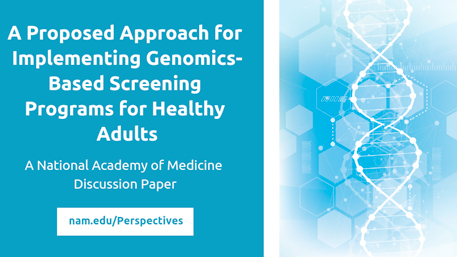Category: Population screening
The Promise of Population-based Genomic Screening for Selected Hereditary Conditions: Contributions of Cost-Effectiveness Analysis

It is estimated that 3 million people in the United States carry pathogenic variants that increase their risks for heart disease and cancer. If people with such variants are identified, medical interventions are available to significantly reduce morbidity and mortality. However, existing recommendations tend to emphasize family-based or ethnic-specific criteria to determine at-risk individuals for Read More >
Posted on by 1 CommentPopulation-based Genomic Screening Programs: The Need for Optimal Implementation to Ensure Health Equity

Population genomic screening of adults has emerged as a strategy to promote prevention of common diseases such as cancer and heart disease among persons with genetic conditions. This type of screening has the potential to identify millions of currently undetected people in the United States who are at risk of preventable diseases for which evidence-based Read More >
Posted on byPopulation Screening for Rare Pathogenic Variants as the Low Hanging Fruit for Public Health Genomics Across the Lifespan

Rapid advances in human genome sequencing technologies have accelerated the integration of genomics into clinical practice. Genomics has demonstrated clinical utility as a diagnostic tool for certain diseases, but its potential for population screening is still work in progress. In principle, DNA-based population screening can identify persons with rare pathogenic variants who are at high Read More >
Posted on by 1 CommentPopulation Genomic Screening is Here: We Need Evidence on Health Impact and Optimal Implementation

A recent study identified 12 population-based genomic screening programs in the United States and described their implementation logistics and potential health impact. In the past decade, the promise of genomic screening in the general population has garnered increasing interest due to a combination of factors such as enhanced sequencing capabilities, lowered costs of testing, and Read More >
Posted on by 2 CommentsFrom Genes to Public Health: Building the Evidence Base for DNA-based Population Screening

This blog post is a summary of our recent commentary in Genetics in Medicine. The use of genetics in population screening long predates the Human Genome Project. For more than 60 years, newborn screening has been a successful public health program that has resulted in major improvements in outcomes for infants with genetic and other Read More >
Posted on byAre We Ready for Population Screening for Hereditary Hemochromatosis?

Hereditary Hemochromatosis (HH) is an inherited iron storage disorder in which the body builds up too much iron, damaging tissues and organs. In most people, HH is caused by two copies of a specific change (mutation) in the HFE gene which is most commonly found in people of European ancestry. In the United States, over Read More >
Posted on by 1 CommentThe Long Road to Population-based Genomic Screening

Since 2012, the CDC Office of Genomics and Precision Public Health (OGPPH) has identified three autosomal dominant conditions for which there exist evidence-based recommendations to prevent morbidity and mortality from either cancer or heart disease. Using our evidence-based framework, we have collectively labeled the following conditions as tier 1 genomic applications: 1) hereditary breast and Read More >
Posted on by 3 CommentsAre we Ready for DNA-based Population Screening? The Need for Large Collaborative Pilot Studies

This blog is a summary of a recent viewpoint published in the Journal of American Medical Association. There is increasing evidence that accepted approaches using medical history-based screening fail to identify the majority of individuals with genetic conditions associated with cancer and heart disease, including CDC tier 1 applications, such as hereditary breast and ovarian Read More >
Posted on byImplementing Genomics-Based Screening Programs for Healthy Adults: A Proposed Evidence-based Approach from the Genomics and Population Health Action Collaborative

The following report was developed by the Genomics and Population Health Action Collaborative (GPHAC) as a potential roadmap for groups planning to carry out projects involving genomics-based screening programs in the healthy adult populations. The report is available in its entirety on the National Academy of Science, Engineering and Medicine website. The advent of next Read More >
Posted on byHow Can We Use Genetic Testing in Population Screening for Common Diseases?

Scientific and implementation challenges Population screening for disease is a concept that has been around for many decades. Its main purpose is early detection and treatment of asymptomatic disease, or risk assessment and prevention of future disease, in order to improve health outcomes in individuals and populations. Examples include mammography in breast cancer screening and Read More >
Posted on by 1 Comment

